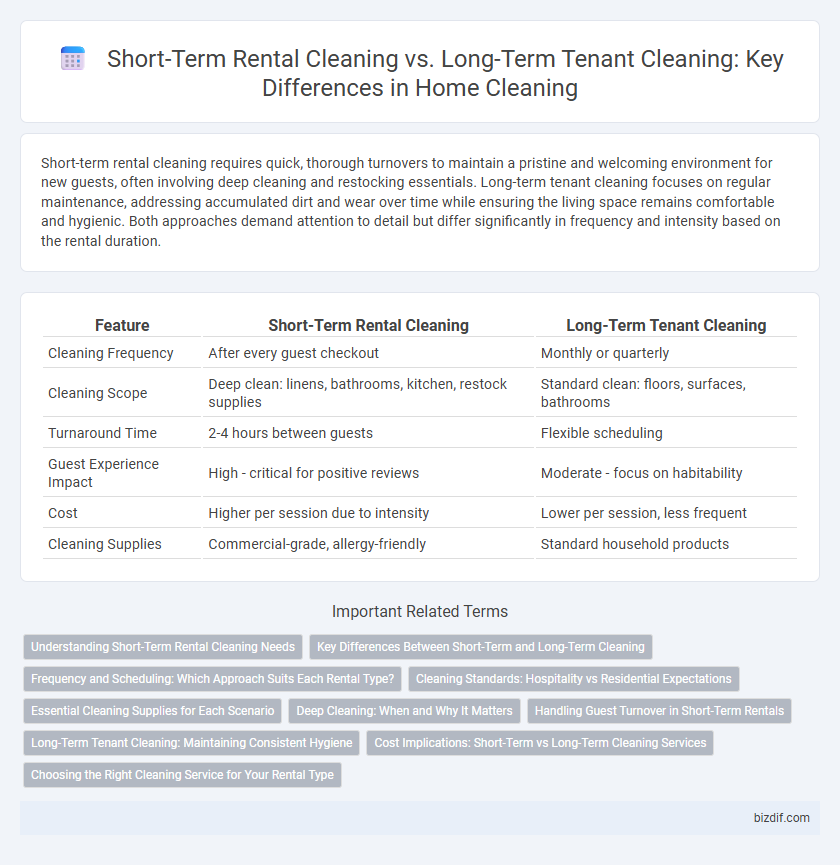Short-term rental cleaning requires quick, thorough turnovers to maintain a pristine and welcoming environment for new guests, often involving deep cleaning and restocking essentials. Long-term tenant cleaning focuses on regular maintenance, addressing accumulated dirt and wear over time while ensuring the living space remains comfortable and hygienic. Both approaches demand attention to detail but differ significantly in frequency and intensity based on the rental duration.
Table of Comparison
| Feature | Short-Term Rental Cleaning | Long-Term Tenant Cleaning |
|---|---|---|
| Cleaning Frequency | After every guest checkout | Monthly or quarterly |
| Cleaning Scope | Deep clean: linens, bathrooms, kitchen, restock supplies | Standard clean: floors, surfaces, bathrooms |
| Turnaround Time | 2-4 hours between guests | Flexible scheduling |
| Guest Experience Impact | High - critical for positive reviews | Moderate - focus on habitability |
| Cost | Higher per session due to intensity | Lower per session, less frequent |
| Cleaning Supplies | Commercial-grade, allergy-friendly | Standard household products |
Understanding Short-Term Rental Cleaning Needs
Short-term rental cleaning requires a faster turnaround and more detailed attention to high-use areas like kitchens and bathrooms to ensure guest satisfaction and positive reviews. Unlike long-term tenant cleaning, it involves frequent deep cleaning between stays, including laundering linens and restocking essentials. Efficient management of these tasks directly impacts occupancy rates and overall rental income.
Key Differences Between Short-Term and Long-Term Cleaning
Short-term rental cleaning requires rapid, thorough turnover with high attention to detail, including linen changes, restocking supplies, and sanitation to meet guest expectations. Long-term tenant cleaning often involves deeper cleaning performed less frequently, focusing on maintenance tasks like carpet cleaning and appliances, with less emphasis on immediate turnaround. Key differences include the cleaning frequency, scope of tasks, and the urgency tied to occupancy change versus ongoing habitation.
Frequency and Scheduling: Which Approach Suits Each Rental Type?
Short-term rental cleaning requires frequent, often same-day turnovers with flexible scheduling to accommodate back-to-back guest arrivals, ensuring spotless readiness and hygiene standards. Long-term tenant cleaning typically follows a less frequent, routine schedule such as monthly or quarterly deep cleans, focusing on maintenance and upkeep rather than rapid turnaround. Proper alignment of cleaning frequency and scheduling with rental type maximizes guest satisfaction and property condition.
Cleaning Standards: Hospitality vs Residential Expectations
Short-term rental cleaning adheres to hospitality standards, emphasizing meticulous sanitization, pristine presentation, and rapid turnover to ensure guest satisfaction and high review scores. Long-term tenant cleaning follows residential expectations, focusing on thorough maintenance, deep cleaning of living areas, and addressing wear and tear over extended occupancy periods. Both require attention to detail, but short-term cleaning prioritizes aesthetics and immediate guest readiness, while long-term cleaning emphasizes durability and ongoing cleanliness.
Essential Cleaning Supplies for Each Scenario
Short-term rental cleaning demands quick turnaround with essential supplies like disinfectant sprays, microfiber cloths, and odor neutralizers to ensure guest satisfaction and hygiene. Long-term tenant cleaning requires deeper cleaning tools such as heavy-duty vacuum cleaners, carpet shampoos, and mold removers to maintain property condition over extended periods. Tailoring cleaning supplies to each scenario enhances efficiency and promotes a healthier living environment.
Deep Cleaning: When and Why It Matters
Deep cleaning is crucial for short-term rental properties between guest stays to maintain high hygiene standards and positive reviews. In long-term tenant cleaning, deep cleaning typically occurs during move-in or move-out to address accumulated dirt and allergens. This thorough approach ensures a healthy living environment and prolongs the life of fixtures and surfaces.
Handling Guest Turnover in Short-Term Rentals
Efficient handling of guest turnover in short-term rentals requires rapid, thorough cleaning to prepare the property between stays, ensuring high guest satisfaction and positive reviews. Unlike long-term tenant cleaning, which is more periodic and less time-sensitive, short-term rental cleaning demands detailed attention to disinfecting surfaces, replenishing essentials, and inspecting amenities within tight time frames. Utilizing specialized cleaning checklists and professional services streamlines the turnover process, reducing vacancy periods and maximizing rental income.
Long-Term Tenant Cleaning: Maintaining Consistent Hygiene
Long-term tenant cleaning emphasizes maintaining consistent hygiene through thorough, scheduled deep cleanings that address accumulated dust, allergens, and wear. This approach ensures the property remains fresh and sanitary over extended periods, reducing health risks and preserving surfaces. Regular cleaning routines in long-term rentals improve tenant satisfaction and help prevent costly repairs due to neglect.
Cost Implications: Short-Term vs Long-Term Cleaning Services
Short-term rental cleaning typically incurs higher costs due to frequent turnovers and intensive cleaning requirements to maintain hotel-like standards, often involving deep cleaning after every guest. Long-term tenant cleaning tends to be less expensive as it involves routine maintenance and less frequent deep cleans, reducing labor and supply expenses over time. Property owners must balance these cost implications against the rental strategy to optimize their cleaning budget effectively.
Choosing the Right Cleaning Service for Your Rental Type
Short-term rental cleaning requires thorough turnaround services, including deep disinfection, linen changes, and fast scheduling to accommodate frequent guest turnovers. Long-term tenant cleaning focuses on routine maintenance and periodic deep cleans to maintain hygiene and comfort throughout extended occupancy. Choosing the right cleaning service depends on the rental frequency, with specialized providers offering tailored solutions for either high-volume short stays or sustained cleanliness for long-term tenants.
Short-Term Rental Cleaning vs Long-Term Tenant Cleaning Infographic

 bizdif.com
bizdif.com